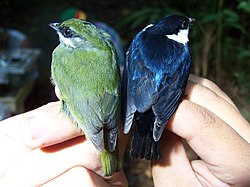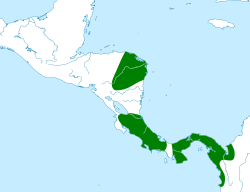Breeding
Like other manakins, this species has fascinating, breeding biology. [3] Males display at leks. These consist of multiple fallen mossy logs on or near the forest floor within earshot of one another. Males can display alone or in coordinated displays with other males. Their displays consist of slow fluttering "butterfly" flights to and from their logs and between nearby perches, log landings and "throat flags" while crouched and flicking wings. The culmination of the display consists of a butterfly flight from the log circling up above the forest canopy, above-canopy flights accompanied by high, thin "seeuw-seeuw" calls, then a high speed dive to the log, followed by a jump and about-face. [4] Males make three sounds during the dive and jump portion of the display, characterized as "flap-chee-wah". [5] Females visit multiple logs and select a male with whom to mate. If she is interested, she will land on a males' log. Copulation always occurs on the log, and is preceded by the flap-chee-wah display with the male doing his final jump over the female and copulating immediately afterward. [6] Young males often practice displays, sometimes in groups of 4–5, typically on logs that are not used by adults in that season. The degree to which males display together varies widely and is relatively constant within a season. Relative to other manakin species, male ownership of log, and log use from year to year are relatively dynamic with ~40% of them turning over between years at one site. [3] The female lays two brown-speckled white eggs in a shallow cup nest 5–7 m high in a horizontal tree fork. Nest-building, incubation for 18–21 days, and care of the young are undertaken by the female alone, since manakins do not form stable pairs. In Central America, males display primarily from March through May and peak fledging appears to occur in June based on mist-net records. [3] This corresponds to the driest months of the year.
Food and feeding
The white-ruffed manakin feeds low in the trees on fruit and some spiders and insects, both plucked from the foliage in flight. Males are highly frugivorous, with over 90% of their diet being fruit. [7] Females increase the proportion of arthropods in their diet during the breeding season. [8] A large proportion of their diet consists of small berries produced by plants in the Melastomataceae. [9] Manakins forage alone or sometime forms loose groups in its breeding areas (particularly bands of young males), but is more solitary in the lowlands, although it may join tanagers and others in mixed-species feeding flocks.
Molt occurs on breeding grounds, initiated first in young males as early as July, followed by reproductive-aged (i.e. 4th year or older) males, and then females. At the population-level, it can be relatively protracted, lasting through to October. In altitudinal migrant populations, downhill movements occur during or immediately following heavy, multi-day rainstorms starting as early as July, and continuing through the latter half of the year. [10] Once birds reach lower-elevation non-breeding areas, they remain there until uphill migration in February. Males are more likely to migrate than females. [1]

